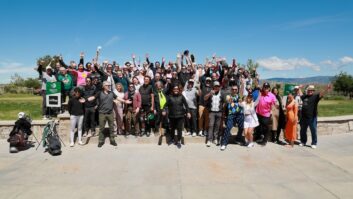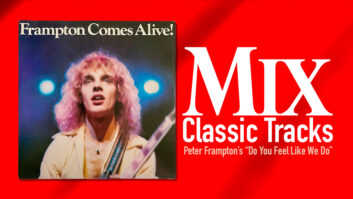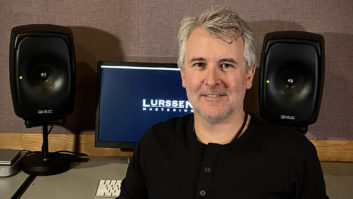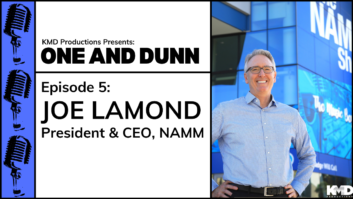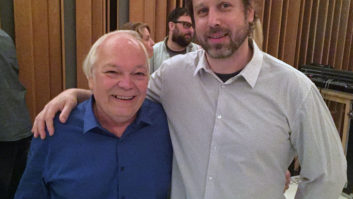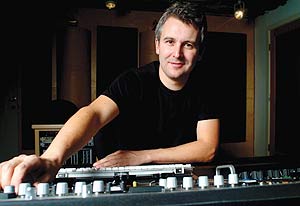

Two years ago in this space, Mix reported on veteran Mastering Lab owner/engineer Doug Sax’s move to Ojai, Calif., near Santa Barbara, where he started fresh with a new facility and a new outlook. However, Sax wasn’t the only mastering pro to turn a corner after the Mastering Lab relocated.
The owner/operator of this month’s cover studio, Gavin Lurssen, is a two-time Grammy winner who began his career at the Mastering Lab in 1991 as a runner. A graduate of Berklee College of Music, he was fortunate to then apprentice with Sax, one of the most respected mastering engineers in the country. Lurssen has built a career and a reputation based on a careful blend of old and new methods and technologies. When Sax moved his facility north, Lurssen took the opportunity to open his own shop, and business has been booming since Lurssen Mastering went online one year ago.
Gavin Lurssen’s Lurssen Mastering houses a broad range of new and old technologies.
Photo: Jason Vaughn
“The thing I’m most pleased and satisfied with is the way we’ve been accepted into the community,” says Lurssen. “What’s really remarkable to me is all the people making a living in this community look at it as that: a community. When I moved, I got well wishes from studios we work with, from competing mastering facilities. There’s a general sense of good will. If the community survives, then we all survive.”
With that general good feeling, and the help of mixer friend Dan Garcia and technician Charlie Bolois, Lurssen built his new facility in a 3,000-square-foot rented building on the Center Stage lot in Hollywood. “It’s a great old building,” Lurssen explains. “It used to be a mill shop to mill wood that would be used on early Hollywood film movie sets in the ’20s. It’s got concrete floors, brick walls, exposed wood ceilings and a loft. It’s got a great vibe to it, a great flow.”
Lurssen and Garcia built all of the acoustical treatments, and Bolois installed Lurssen’s broad, eclectic set of tools. His main mastering platform is Sonic Studio, and he makes extensive use of the system’s 302 soundcard and soundBlade. Also on hand is a complement of digital plug-ins and his analog secret weapons: “I have a lot of choices when it comes to analog equipment — EQs, compressors, limiters, de-essers, specific things like that — but a lot of that has been modified.”
More important than the tools at his disposal, Lurssen says, is a balanced approach to mastering. “With the tools being as available and as inexpensive as they are, anybody can call themselves anything,” Lurssen observes. “You can call yourself a race car driver if you’ve got the money to buy a race car, but it doesn’t mean you know how to drive it. That’s an analogy that Doug makes. But from Doug I learned the importance of being responsible with audio transfers. A lot of people think of me as a combination of new school and old school, and I suppose what they mean by that is I understand things like gain structure and how to convert between analog and digital without destroying the audio signal.
“In today’s world, you have to compete with a lot of noise coming at you,” he continues. “Not only the audible noise of a CD or an iPod you’re listening to, or even the noise of ambient traffic around you, but even visual ‘noise.’ There’s so much information coming at your brain that CDs, as a result, have been getting louder and louder. I like to think that I’m able to provide some good level on a disc, but in a responsible way.”
Lurssen was somewhat concerned about what would happen to his client base once he opened the new studio, but he was pleasantly surprised that all of his regular clients went with him. Like most successful mastering engineers, he works on a tremendous variety of material, including punk and indie rock albums, folk, film and videogame soundtracks, and a new type of project he finds increasingly common: production music libraries.
“Everything you ever listen to is mastered,” Lurssen explains, “so when a music supervisor looks for a piece of music, they expect it to have that mastered sound. The library company will want to go see a mastering person to give it the ‘juice.’”
Other notable projects Lurssen has mastered this year include the soundtracks for the films Ratatouille and Across the Universe; the game score for God of War II; and album projects for Lucinda Williams, Tom Waits, Aimee Mann, Matchbox 20, Tomahawk, and Allison Krauss and Robert Plant’s Raising Sand, which is profiled in this month’s “Recording Notes“ section.
“I’ll get a reputation for working with T Bone Burnett [with whom he shares the Grammy for Album of the Year for O Brother, Where Art Thou?],” Lurssen says. “You get known for a certain sound and people come for that, but there will be another bunch of people who know me for another sound. We can work on a classical soundtrack one day and a punk rock thing the next. The genres know no bounds.”
Barbara Schultz is a Mix assistant editor.

Related Articles
Lurssen’s Lab
Mar 1, 2007 12:00 PM, Compiled by Barbara Schultz
After 15 years, a Grammy and a number of Oscar nominations, Gavin Lurssen has left Doug Sax’s Mastering Lab to open his own mastering facility, Lurssen…
Class of 2007
Jun 1, 2007 12:00 PM
Great Divide Studios Jamie Rosenberg’s Great Divide Studios in Aspen, Colo., is the fourth facility to bear the Great Divide name, and it’s a huge upgrade…
